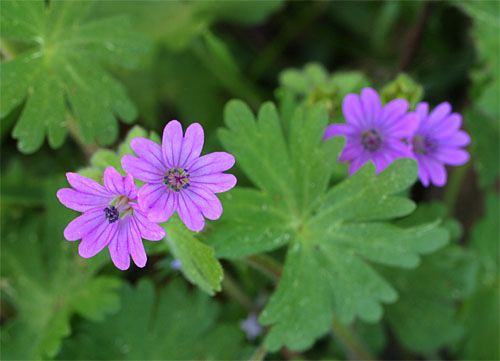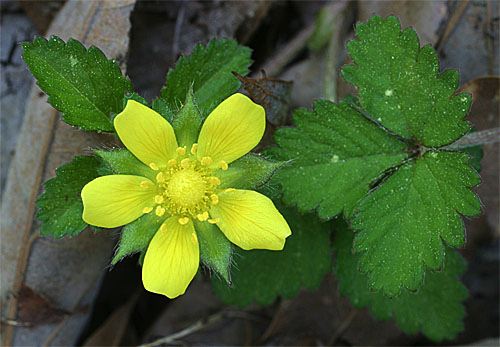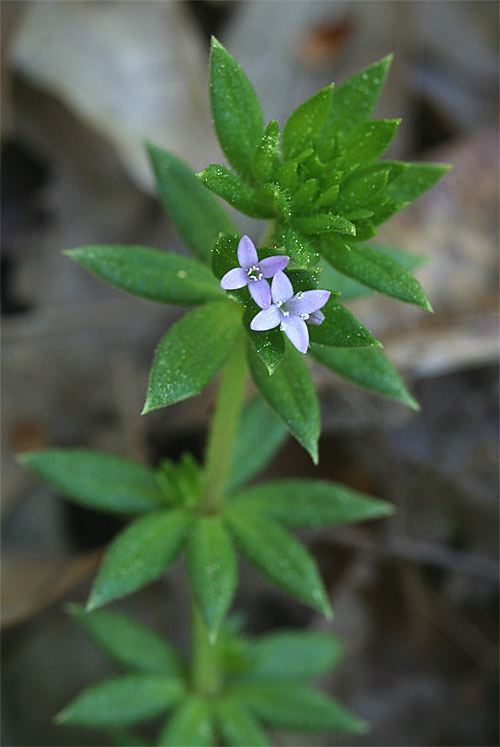FRONT LAWN FLOWERS:
TINY AND OVERLOOKED (Part 2)
Every spring at Hilton Pond Center we try to ignore momentarily the profusion of showy blooms on our Eastern Redbud and Flowering Dogwood trees. It's not that we dislike the floral display offered by these native trees--or by the blossoms of ornamental Daffodils, Forsythia, and Spirea that were planted by former owners of the property. It's just that we've taken a real interest in finding obscure flowering plants that might be overlooked if we only concentrate on the obvious. At about this time back in 2003 we found some true mini-wonders in the small patch of grass in front of the Center's old farmhouse, so this year we thought we'd check again to see if any new species had cropped up in what we'll admit without shame is a poorly manicured lawn. Sure enough, because we did NOT run the lawn mower and DID take time to get down on hands and knees, we were delighted to encounter four tiny new flowers we could eventually identify and add to the list of flora at Hilton Pond Center. Granted, all turned out to be non-natives and might even have invasive tendencies, but because they're small AND have interesting blossoms AND since we probably couldn't eradicate the plants anyway, we decided to let them be and share their structures photographically.

All text & photos © Hilton Pond Center
It's possible that all these flowers have been existing in our front lawn during the entire 24-year period we've been at what is now Hilton Pond Center. Perhaps we weren't attentive enough, or maybe we did run the mower before the plants had a chance to bloom. In any case, two of the more noticeable flowers this year were shades of pink and purple. Although their blossoms were quite similar--five petals each split slightly at the tip so that there appeared to be ten petals instead. It's a given in the plant world that if their flowers are very similar then plants are probably related, even though--as in this case--the foliage might be significantly different. It was actually good that the plants' leaves varied greatly in shape, because that's what helped us determine which two species we had found after we determined both were in the Geraniaceae (Geranium Family). The first plant, Geranium molle (above), is sometimes called Dove's-foot Cranesbill. It has leaves that are rounded but with moderate incisions that separate them into five broad lobes sort of like the fat toes of a Mourning Dove and hence the common name. In this species the pinkish-purple flowers are almost always paired.

The second plant (above) was Geranium dissectum, AKA Cut-leaf Cranesbill. The species is aptly named, since the leaves are heavily dissected; in this case the five lobes look like a "typical" bird's skinny toes. Its flowers are usually single rather than being paired or in clusters. Our two wild geraniums are called "Cranesbill" because their fruiting bodies are long and pointed and bulbous at the base, superficially resembling the mouth parts of a Sandhill Crane. Both species are European imports that have become naturalized throughout eastern North America and beyond. What's not apparent from the photos above is that these simple geraniums are nothing like the big compound-flowered ones that folks plant in front porch pots; the two Cranesbills have flowers only a quarter-inch across, which is why we easily could have overlooked them in the past!

The third new plant we found this week in the lawn at Hilton Pond Center had a much larger flower than the Cranesbills--almost an inch across. This bright yellow blossom looked almost like an old-fashioned rose, with five big petals and lots of pollen-bearing stamens. That plus the compound leaf--divided in this case into three broad leaflets--gave us a pretty good idea we were dealing with a plant in the Rosaceae, the Rose Family. Sure enough, when we looked closely at the bloom and also noticed the five pointed bracts that made a green star beneath the yellow petals, we knew we had Indian Strawberry sharing the lawn with cranesbills. Also referred to as Mock Strawberry because the fruit is essentially tasteless when compared to "real" wild strawberries, Indian Strawberry is so-called not after Native Americans but because it comes from India, hence its species name of Duchesnea indica. This plant also has escaped and adapted well to disturbed areas across the North American continent.

Growing right alongside the Indian Strawberry was a plant with flowers so small they REALLY could be over-looked. In fact, we had noticed the foliage on this plant during early summer but hadn't seen the blooms until this year. The leaves were quite distinctive, growing in flat whorls of six at regular intervals along a square stem that was more or less prostrate. Although flowers with three or five parts are relatively common, this plant's light blue blossoms were four-parted, i.e., four petals, four stamens, etc. Only an eighth of an inch across, they resembled the slightly larger Bluets that grow along the trails around Hilton Pond, so we suspected the plant as in the Rubiaceae (Madder Family) and, sure enough, this new plant keyed out to be Field Madder, Sherardia arvensis--yet another European import that is found especially in the Piedmont Region of the eastern U.S.
So now you know the results of our latest ground-level excursion through the grass at Hilton Pond Center, armed with tripod, digital camera, and macro lens. Today the Center's checklist has four new flowering plant species, none of which were present on this continent before Europeans arrived, and all of which have blossoms that easily could be missed. Foreign imports all, in our judgment they're still worth studying as we document the amazing diversity of tiny, overlooked flowers in the old front lawn.
All text & photos © Hilton Pond Center
Comments or questions about this week's installment?
Please send an E-mail message to INFO.
NOTE: Be sure to scroll down for an account of all birds banded or recaptured during the week, as well as some other interesting nature notes.
"This Week at Hilton Pond" is written & photographed
by Bill Hilton Jr., executive director of
Hilton Pond Center for Piedmont Natural History.
You may wish to consult our Index of all nature topics covered since February 2000. You can also use the on-line Search Engine at the bottom of this page.
For a free, non-fattening, on-line subscription to "This Week at Hilton Pond," just send us an E-mail with SUBSCRIBE in the Subject line. Please be sure to configure your spam filter to accept E-mails from hiltonpond.org.
|









